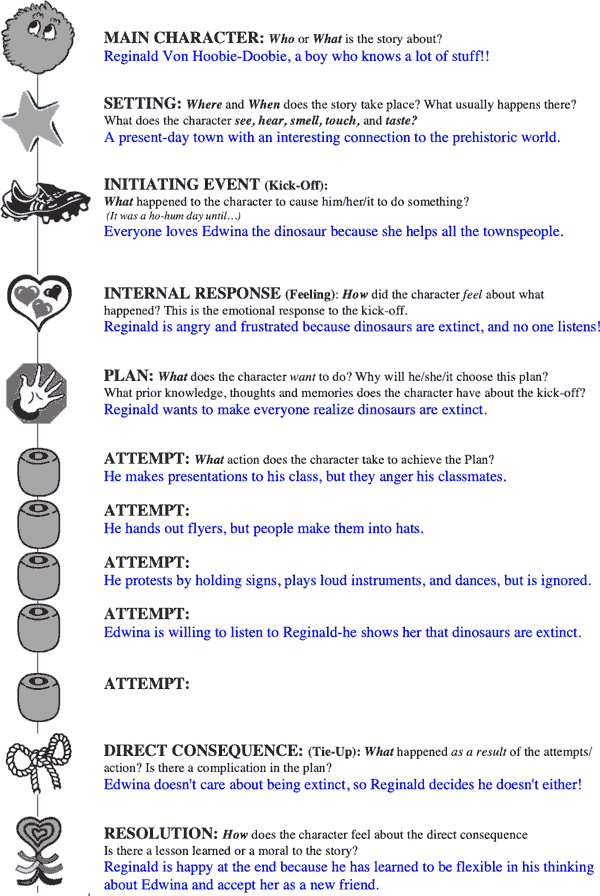Menu
-
- Home
-
About Us
-
The Approach
-
Focus Areas
-
MindWing Learning
-
Learning Resources
-
SHOP
-
Blog
-
- About MindWing
- Our People
- Contact Us
- Your Account
- Login
-
United States (USD $)

Dinosaurs, Narrative, and Flexible Thinking
by Sean Sweeney March 02, 2011 2 min read 2 Comments
I always love finding resources that serve as a context for addressing many speech and language-related skills. The wonderful book Edwina – The Dinosaur Who Didn’t Know She was Extinct by Mo Willems is one of those resources; it can be used to target narrative and expository formulation, as well as social thinking skills in several areas.

To begin with, Edwina is a story that will engage and delight children from early to late elementary ages, beginning with its title and the name of the main character, Reginald Von Hoobie-Doobie. Reginald has a problem: everyone around him is enthralled by Edwina, the friendly town dinosaur, and no one heeds his increasingly emphatic pleas to accept that Dinosaurs! Are! Extinct! The structure of the story is perfect for mapping as a complete episode using Braidy or Story Grammar Marker, as can be seen below:

Though this story has the twist of having the main character be both strangely right and wrong at the same time, it also provides a great context for building skills essential for children with autism spectrum disorders and other social pragmatic issues. The key problem in the story is mainly one of perspective, and could be visualized for students using the SGM Universal Magnets, Perspective Taking Maps (with icons down the middle and competing perspectives on either side), or Critical Thinking Triangle as discussed in the Making Connections volume of Mindwing’s Autism Collection to develop perspective taking skills.
Edwina also is a nice teaching tool if you are using Michelle Garcia Winner and Stephanie Madrigal’s terrific Superflex program, which reviews Social Thinking® skills in the context of a comic book world. We can all relate to the ongoing battle between Superflex, who helps us use flexible thinking and problem solving skills, and the Team of Unthinkables, characters who try to force the citizens of Social Town to act in certain “Unexpected” ways. One of the leaders of the Unthinkables is Rock Brain, who gets us “stuck” in patterns of rigid thinking and on our own wants and ideas. Although Reginald does exhibit some flexible thinking in the varied ways he approaches his problem, the fact that he views Edwina’s existence as a problem at all is an example of a “Rock Brain Moment,” one you can analyze with students using that program’s “Find the Unthinkable Rock Brain” activity. One illustration in Edwina provides a perfect stopping point and discussion of Rock Brain thinking, as Reginald protests Edwina’s distribution of cookies in the park by carrying a sign that reads “This is NOT happening!!!”
Finally, Edwina can be used to target expository language in several ways. Try researching extinct animals and make a list (BrainPop’s clip on Extinction is a great place to start if you have a subscription or free trial) using Thememaker’s List Map, or perhaps a sequence of how a particular animal died out. As we only see a bit of Reginald’s presentation on “Things that are Extinct,” perhaps your students could continue his project in PowerPoint form! The story also has several embedded lists, such as the ways Edwina helped the townspeople, and cookies play a key role, so why not work on writing and completing the sequence of making actual cookies!
Sean Sweeney
Sean Sweeney, MS, MEd, CCC-SLP, is a speech-language pathologist and technology specialist working in private practice at the Ely Center in Needham, MA, and as a clinical supervisor at Boston University. He consults to local and national organizations on technology integration in speech and language interventions. His blog, SpeechTechie (www.speechtechie.com), looks at technology “through a language lens.” Contact him at sean@speechtechie.com.
2 Responses
Cheryl
May 30, 2022
The structure of the story does not show on this post:( Are you able to add it?
Many thanks!
Leave a comment
Comments will be approved before showing up.

Webmaster
May 30, 2022
Thanks for bringing this to our attention! The program Flash is no longer supported by modern browsers, so this picture no longer showed up. We fixed it!